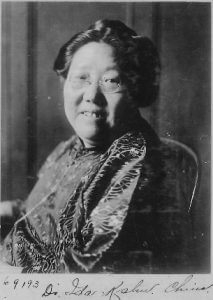One of the first Chinese medical doctors

Kang Cheng, also known as Ida Kahn, was born into a poor family in Jiujiang (Kiukiang), Jiangxi province. She was adopted by Gertrude Howe, a student of the University of Michigan, and left school to work as a missionary in Jiujiang before completing her degree. During Kang’s childhood, she studied at Rulison-Fish Memorial School, established by Howe. At the age of nine, Kang traveled and lived with Howe in San Francisco, Japan and Chongqin (Chungking), China, and did not return to Jiujiang until 1886.
In 1892, upon graduation from the Jiujiang girls’ school, Kang and her close friend Shih Mei-yu (Mary Stone) were sent by Howe to study medicine in Howe’s alma mater, the University of Michigan. The two were the first Asian women to graduate from Michigan in medicine, receiving their degrees in 1896. Upon graduation, Kang and Shi returned to work in Jiujiang as medical missionaries of the Woman’s Foreign Missionary Society of the Methodist Episcopal Church, and treated over 2,000 patients in the first 10 months in their one-room hospital.
They started to propose a new hospital project in 1898 sponsored by Isaac Newton Danforth, a well-known medical doctor in Chicago, but the project had to discontinue due to the Boxer Rebellion in 1900. Kang had to flee for refuge in Japan.
In 1901, she returned to Jiujiang, again helping Shi Meiyu establish the Elizabeth Skelton Danforth Hospital. Two years later, invited by officials in Nanchang, Kang left Jiujiang and set up a new hospital in Nanchang, supported by the contributions of local people.
In 1908, she went to study literature at Northwestern University in the United States, receiving a bachelor’s degree in 1911. She was given an honorary master’s degree from the University of Michigan in 1920.
Kang was frequently involved in social welfare and relief work. Her hospital at Nanchang treated thousands of refugees and wounded soldiers during the revolution of 1911 and the Northern Expedition of 1926. She served as a member of the Tianjin Christian Union Flood Relief Committee to help the needy when a flood struck Tianjin (Tientsin).
In addition to taking care of patients, she was concerned about medical education, evangelistic work, and women’s issues. She attended a number of ecumenical and church conferences as a delegate from China. She spoke at the Edinburgh World Missionary Conference of 1910 and attended the world conference of the YWCA in Berlin the same year. She also served as a committee member of the National Christian Council of China, formed in 1922. She was the author of An Amazon in Cathay (1912) and numerous articles.
Kang was burned out by long-term heavy work. In 1930, she died in Shanghai at the age of 58.
By Kwok Pui-lan
This article is reprinted from Biographical Dictionary of Christian Missions, Macmillan Reference USA, copyright 1998 Gerald H. Anderson, by permission of The Gale Group; Wm. B. Eerdmans Publishing Co., Grand Rapids, Michigan. All rights reserved. It is taken, with permission, from the Biographical Dictionary of Chinese Christianity.
Sources
Kang’s articles include “The Doctor’s Opportunity in Visiting Homes,” Woman’s Work in the Far East 35, no. 4 (December 1914): 170-174 and “The Place of Chinese Christian Women in the Development of China,” Chinese Recorder 50 (1919): 659-662.
Her biography is found in Margaret Burton, Notable Women of China (1912).
Her personal papers are in the archives of the United Methodist Church in Madison, New Jersey.
Kwok Pui-lan, Chinese Women and Christianity, 1860-1927, Atlanta, GA: Scholars Press, 1992.




